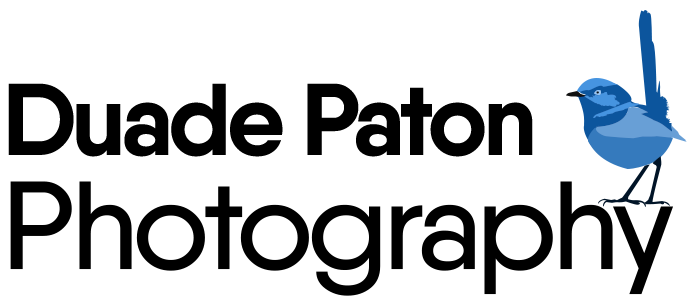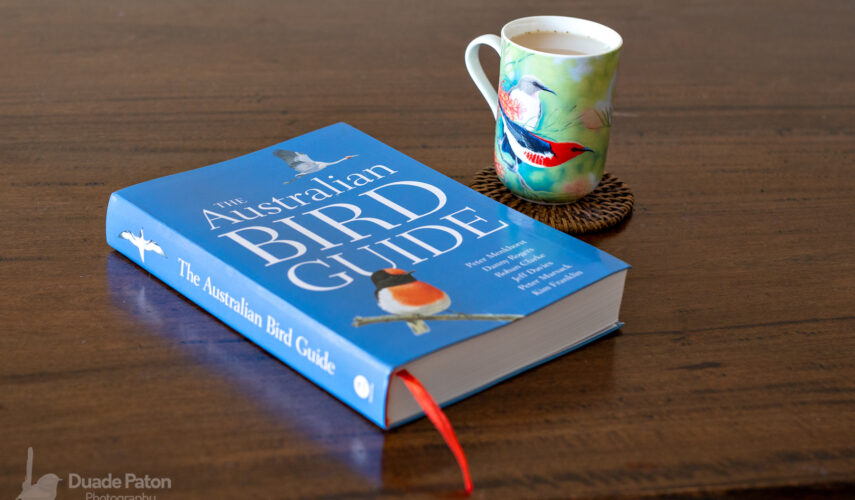The Australian Bird Guide (ABG) is the latest Field Guide to be released for the birds that visit and inhabit Australia.
Australia has approximately 936 bird species recorded in its region since 1940 with 747 breeding residents or regular migrants, 29 introduced and 160 vagrants.
The Australian Bird Guide, 2017
As you can imagine, putting together the perfect field guide is no easy task. There are already several very good field guides available for Australian Birds such as Pizzey & Knights The Field Guide to the Birds of Australia and Simpson & Days Field Guide to the Birds of Australia
I own all of the available field guides and feel I can offer my honest opinion on the ABG and how it compares. I purchased this book with my own money and have not been asked to write a review.

I should note that I was asked by the artwork manager Jeff Davies for a few copies of my photographs for reference material. Of course I was happy to supply them and hope they helped the artists in some way. I have also had the pleasure of meeting author Rohan Clark during a pelagic off Tasmania. Both authors are extremely knowledgeable birders whom I respect greatly.
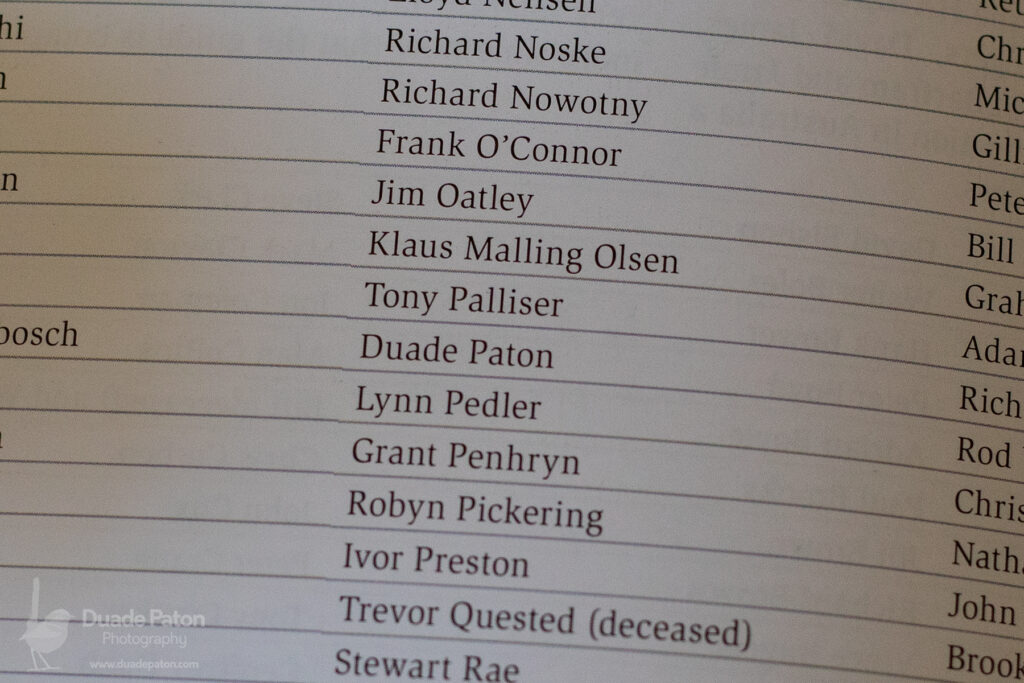
The book itself is very substantial at 566 pages and 1.437kg (3.18pounds), I believe this makes it the biggest current field guide in print. Not one you will likely carry in the field but one you have on the coffee or bedside table.
There are six main contributors, with Peter Menkhorst, Danny Rogers and Rohan Clarke being responsible for the written text. Jeff Davies, Peter Marsack and Kim Franklin are the three artists that created the amazing reference plates. The book also credits Glenn Ehmke with compiling and producing the maps.
Sequence of species
The book has adopted a pragmatic field guide sequence that groups bird families according to the broad biomes in which they are most likely to be encountered. The three main groups of birds being Marine and Coastal Birds, Freshwater Birds and Land Birds.
There is a visual quick reference at the start of the book showing each family/group and the page they start on.

The visual guide works well for experienced Birders but may be a tough ask for anyone who is not well versed in bird families. If you were trying to identify a Blue-faced Honeyeater for example, you would have to know it belonged to the family Honeyeater. Once you know that you now have to find a Honeyeater in the quick reference guide. The bird you need to find is a Yellow-plumed Honeyeater. Quite different in appearance to a BFH!!, alas the difficulty in identifying birds 🙂
Thankfully the book also provides an excellent Alphabetical quick reference to bird groups on page VI at the front of the book. There is also an index in the rear.
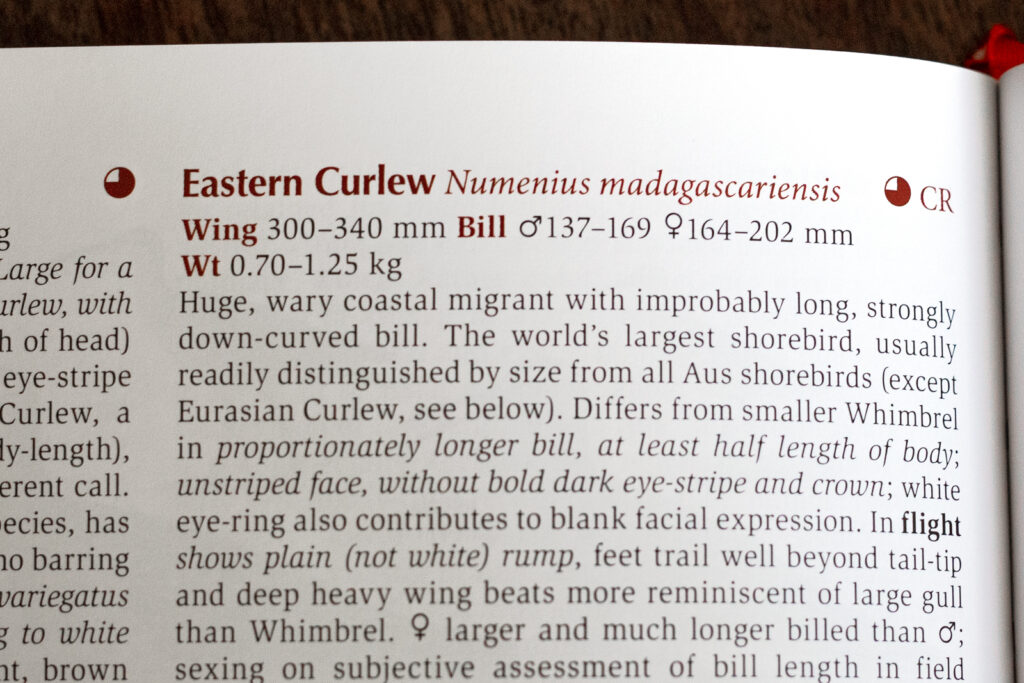
Each species included in the guide starts with its English name, Scientific name, encounter likelihood and conservation status. The likelihood encounter is simple to understand and works on a scale with 5 levels, a solid circle is abundant/very easy, 3/4 solid is common/easy, 1/2 solid is moderately common, 1/4 solid is rare/uncommon and an empty circle is very rare and difficult. This of course relates to the distribution of the species and where you are in relation to its suited habitat.
The Eastern Curlew above has a 3/4 likelihood which means it is common in the right habitat(Coastal tidal mudflats). The CR conservation status means it is critically endangered.
The second line includes the size and weight. The guide uses wing length, bill length and weight to compare species. This can be a little confusing for those used to measuring birds from tail tip to bill. To keep birders happy it is probably easiest to also include the tail to bill measurement.

I have been very impressed with the species accounts and it is clear the authors know their birds well. The notes are also often very helpful and insightful.
Maps
Maps in Australia can be very problematic given the fragmented habitat caused by human disturbance. Some birds require specific habitat for them to breed and survive.
According to the book the distribution maps are based off a database of 16 million records spanning the last 100 years. The maps include regular occurrence and irregular occurrence (lighter shade of colour) and is intended to give a realistic picture of where a bird species can potentially occur.
For example the Glossy Black Cockatoo shows a distribution up and down the east coast of Australia. I find it highly unlikely you will find this bird in major urban areas and large areas of farmland. The bird feeds only on Casuarina trees and will only be found where those trees occur frequently in the woodland.
What this means is for many Australian species you need to find the right habitat within its mapped distribution. Ebird is a great resource to find recent sightings and locations for birds.

I find the maps easy to read and follow. The only criticism is they are a little small and when you get multiple subspecies they can be a little hard to read and distinguish.

Artwork – Bird Plates
The Artwork in this field guide is the best I have seen and the accuracy is incredible. This makes identifying birds so much easier and is one of the core successes in the book.

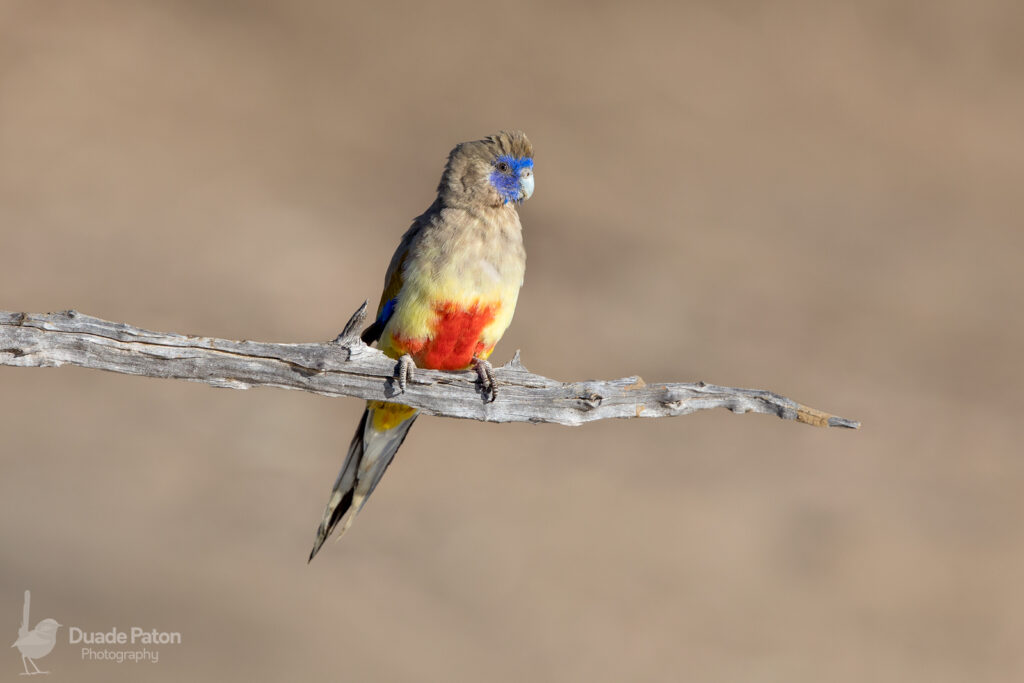
Due to the sheer size and amount of artwork it is no surprise it took 3 artists to create all of the plates. The book claims in excess of 4700 images were needed!!!. As with any art you will likely have a preference for one artist over another however the work is evenly spread and I have not had any major issues thus far.
Jeff Davies
Jeff is reported as being the artwork manager and was responsible for 40% of the plates. I find Jeff’s plates of extremely high quality and he has a distinct style which is very well suited to identification.

If you like Seabirds and Shorebirds you are in for a treat, Jeff Davies has masterfully created some of the most detailed and comprehensive plates I have ever seen. The artwork truly is outstanding and very accurate when portraying jizz and the overall feel of the bird.
I would recommend this book on its marine and coastal birds alone, truly fantastic.
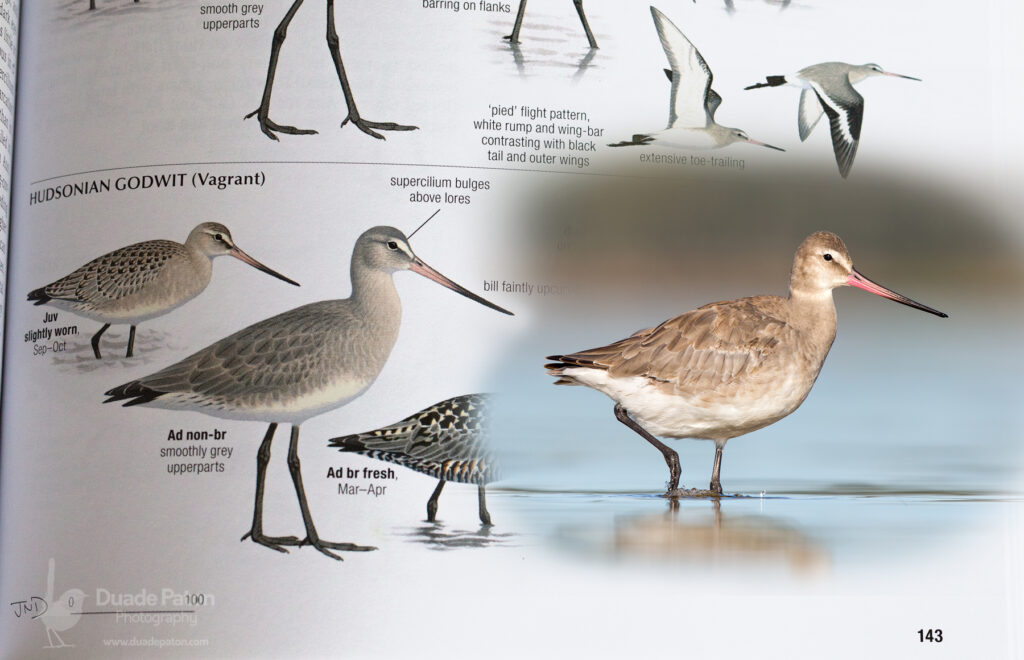
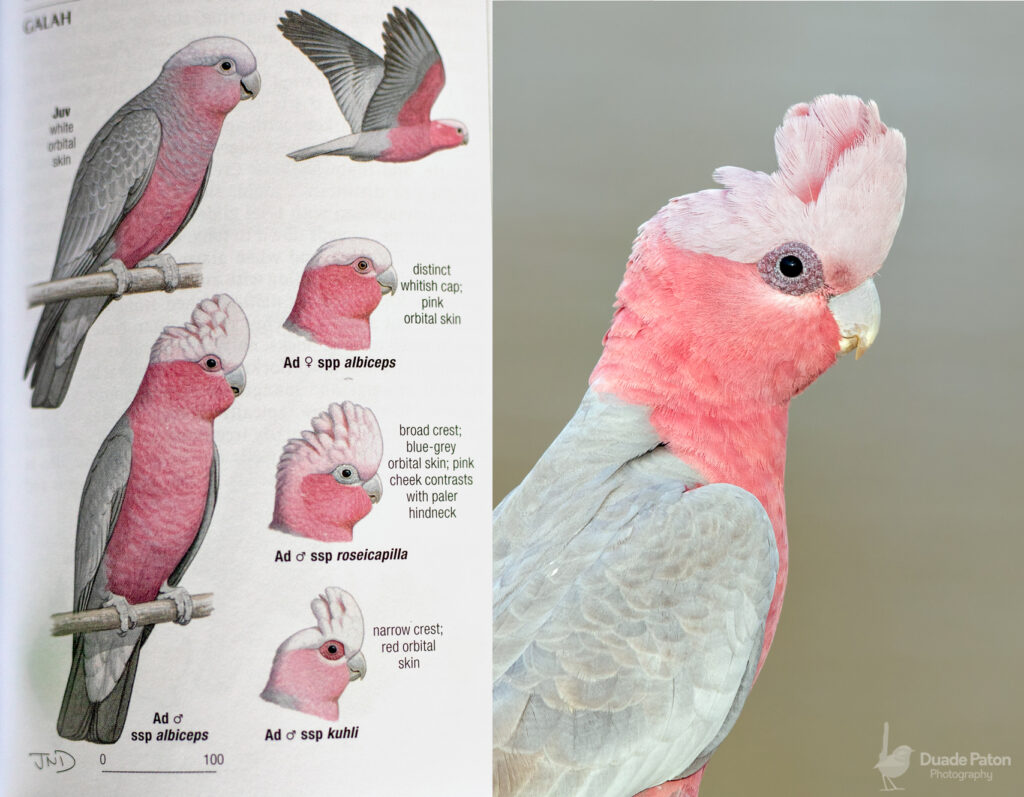
Peter Marsack
Peter is listed as producing 29% of the plates, with a particular focus on passerine species.


Kim Franklin
Kim Franklin produced 31% of the plates and focused efforts on the non-passerines, especially the birds of prey, waterbirds, parrots and pigeons.

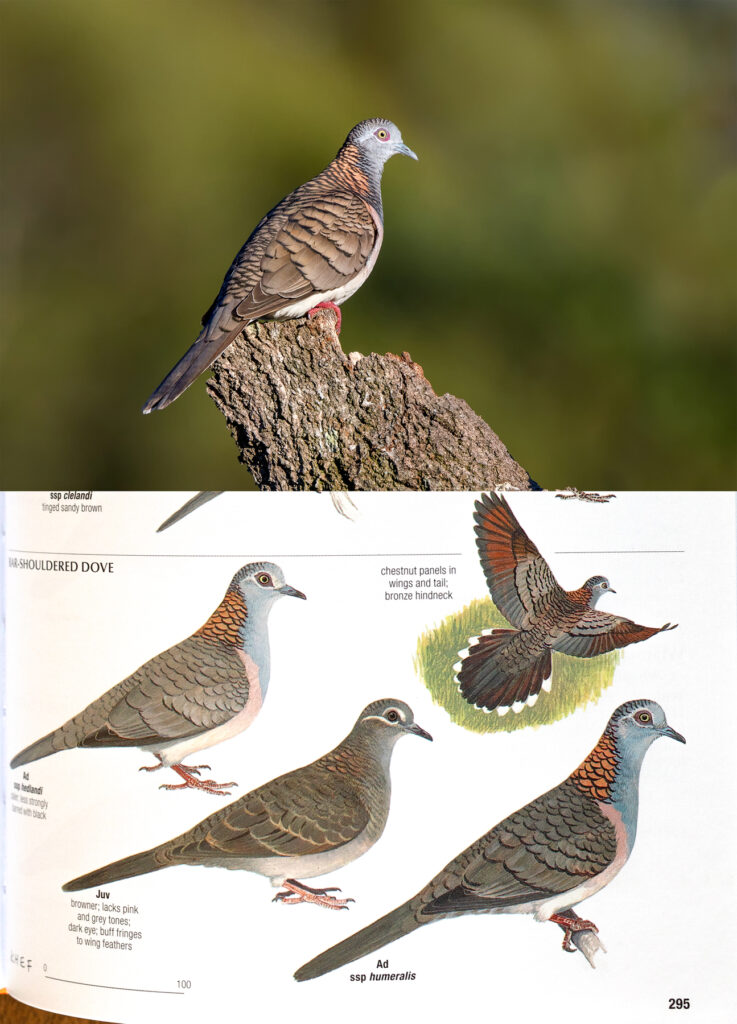
Vagrants
One of the books strong points is the amount of detail that has been allocated to vagrants. The plates are fantastic and it is clear the authors have gone to great lengths to include them. They are also included in the family they belong as opposed to being placed at the end of the book.
You only need to look at the plate below for a White Wagtail to see the amount of detail included in this book.

If I could only pick one Australian Field Guide it would be The Australian Bird Guide.
Duade Paton, 2018
The Index
The biggest issue with the book for most birders has been the index included in the first print of the first edition. Traditional indexes include the family name of the bird such as Albatross and then the different Albatross species below that. All you needed to know was the family and you could quickly find a page number or the included species in that family.
the ABG decided to use a slightly different index which used the scientific and English names only. So to find a Buller’s Albatross you would have to know its scientific or English name. Basically if you didn’t know its correct name the index was useless to you.
Of course you could have used the excellent reference on page VI for bird groups however human habit and field guide standards have people going to the index in the rear for this information.

The authors were quick to act after the feedback and have released an updated index you can glue in the back if you feel the need. I have also read that the second print edition will have the updated index. Download the updated index from CSIRO here.

To be honest I believe the best index would be a combination of both. That is to also include the English name alphabetically as well. Maybe the hardcore birders know all of the scientific names but I assume the majority of people who buy the book will only know the English names.
The second index includes the family name first and then the birds name. So a Blue-faced Honeyeater is only found under Honeyeater – Blue-faced. You will no longer find it under B for Blue-faced Honeyeater.
Conclusion
If I could only pick one Australian Field Guide it would be The Australian Bird Guide. As a matter of fact I am in the process of moving house and the only book I have not packed yet is the ABG.
This book is now my go to field guide for identification and information. I have a special interest in Shorebirds and Seabirds which this book caters for in spades. Before I had to reference specific guides for these species whereas now I can find it all in the one book.
The authors have been very quick to respond to feedback and have already made a number of updates which will feature in the next print. They have also discussed the possibility of an app further down the road should the book sell well enough.
I can only sing praises for this book and highly recommend it as the leading book for Australian Bird Identification and information.
4 Reasons to buy The Australian Bird Guide
- Most detailed and extensive Australian Field Guide available.
- Seabird and Shorebird section is top class and an amazing reference for birds that frequent Australian waters.
- Artwork is detailed and of a high quality allowing easier identification.
- Subspecies and Vagrants are well recorded and included allowing the birder more information when trying to identify hard birds.
